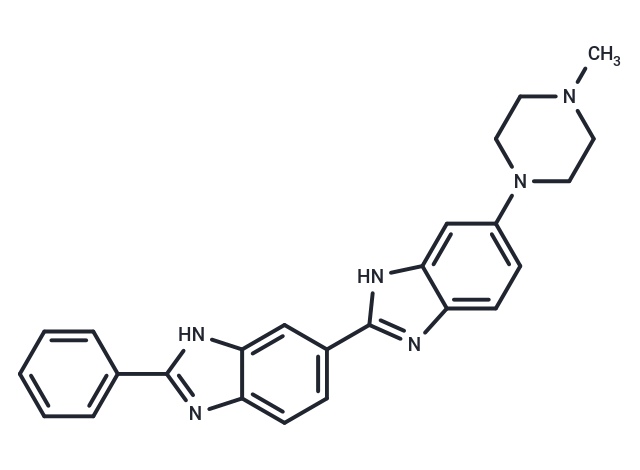Shopping Cart
Remove All Your shopping cart is currently empty
Your shopping cart is currently empty
Hoechst stains are part of a family of blue fluorescent dyes used to stain DNA. HOE 33187 is a cell dye for DNA. Hoechst dyes are cell-permeable and can bind to DNA in live or fixed cells.

| Pack Size | Price | USA Warehouse | Global Warehouse | Quantity |
|---|---|---|---|---|
| 10 mg | $29 | - | In Stock | |
| 25 mg | Preferential | - | In Stock | |
| 50 mg | Preferential | - | In Stock |
| Description | Hoechst stains are part of a family of blue fluorescent dyes used to stain DNA. HOE 33187 is a cell dye for DNA. Hoechst dyes are cell-permeable and can bind to DNA in live or fixed cells. |
| Cell Research | I. Nuclear staining 1. Material preparation: (1) Hoechst 33342 solution: Dissolve Hoechst 33342 in an appropriate solvent, such as water or PBS, with a common concentration of 1-10 µg/mL. (2) Cell samples: Live cells or fixed cells, placed on a slide or in culture. (3) PBS buffer: Used to wash cells and adjust pH. 2. Experimental steps: Live cell staining 1) Add Hoechst 33342 to the cell culture medium to reach the recommended final concentration. 2) Incubate at room temperature or 37°C for 15-30 minutes, depending on the cell type. 3) Wash the cells with PBS buffer to remove excess dye. 4) Analyze the stained cells using a fluorescence microscope or flow cytometer. Excitation wavelength: 350 nm Emission wavelength: 461 nm Fixed cell staining: 1) Fix the cells using an appropriate fixative (such as 4% paraformaldehyde). 2) After fixation, stain the cells as described above, either on a slide or in suspension. 3) Analyze the fluorescence of the cells using a microscope. II. Application of Cell Cycle Analysis 1. Stain apoptotic cells as described above. 2. Examine the cells for morphological changes, such as chromatin condensation and nuclear fragmentation, which are hallmarks of apoptosis. |
| Molecular Weight | 408.5 |
| Formula | C25H24N6 |
| Cas No. | 23623-08-7 |
| Smiles | CN1CCN(CC1)c1ccc2nc([nH]c2c1)-c1ccc2nc([nH]c2c1)-c1ccccc1 |
| Relative Density. | 1.298 g/cm3 (Predicted) |
| Storage | keep away from direct sunlight | Powder: -20°C for 3 years | In solvent: -80°C for 1 year | Shipping with blue ice/Shipping at ambient temperature. | ||||||||||
| Solubility Information | DMSO: 2 mg/mL (4.9 mM), Sonication is recommended. | ||||||||||
Solution Preparation Table | |||||||||||
DMSO
| |||||||||||
| Size | Quantity | Unit Price | Amount | Operation |
|---|

Copyright © 2015-2026 TargetMol Chemicals Inc. All Rights Reserved.